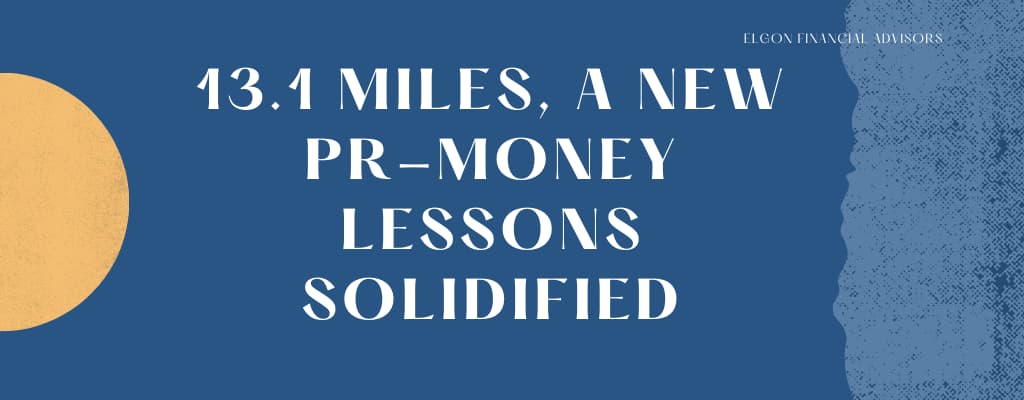This past weekend, I participated in the 3M Half Marathon in Austin. I ended up with a new PR, and a decent placing in my age group – very competitive age group. I’ve done a couple of races, but every one of them feels very different.
This particular race really brought home the idea of implementing a financial plan or investment strategy being very similar to actually running a marathon.
It reinforced how similar the two are, hence the title “Money Lessons Solidified”.
I have previously written about Money Lessons from Marathon Running Training and Fitness.
But running in the actual race reminded me again that winning at personal finance is similar, if not the same, as running a real marathon; it’s not a sprint.
The lessons are very practical and apply to many financial planning and investing journeys.
For example, saving for a business, saving for college, or retirement.
Literally just about every financial goal you can think of can be illustrated by the preparations, the mistakes, and the success on a race course.
Financial Goal Setting And Preparation
Very few people can wake up one day and decide to run a marathon without some training and be successful.
You need to think carefully about your goal, set a specific time, and then develop a plan to accomplish it.
It’s very hard to achieve a financial goal without a plan that you work patiently towards.
A recent survey shows that 65% of people with a written financial plan feel financially stable. 54% felt “very confident” they would reach their financial goals, compared with only 18% of non-planners.
Be very intentional about what you are trying to do, and if you have multiple goals then prioritize.
Should we save for college first, or save for the vacation home?
For the race, you spend months and months of training. In addition there is all the other preparation that goes on the night before, setting out the right clothes, fueling, ensuring you get to the start on time etc.
In my previous article, I discuss a key component, knowing your WHY for what you are doing, running, saving, investing etc. The WHY is going to be what keeps you going when the going gets tough, and it will.
Understand Your Pace And Stick To It
Knowing your pace and sticking to it is sometimes one of the toughest things to do when you’re in a race and requires some self-discipline.
In the race excitement, it’s easy to go a lot faster than you were intending which would be okay, if this is a sprint.
However, doing this in a long-distance race is very expensive and can be almost fatal.
I made this mistake this weekend and tried to keep up with folks out of my league pace-wise, in the first couple of miles, so when it came to the final hills, it was a real struggle.
When it comes to money, knowing your paces means knowing how much you have to spend per month.
It means internalizing this number, so you don’t end up trying to keep up with the Joneses.
If you need to track your spending, there are a lot of budget apps you can use to help you stay within the limits.
Know how much you need to save per month, or per paycheck, and stick with that, and you have a higher chance of success.
You can save more, but it’s essential to do so intentionally, once you understand how it affects your other goals.
Don’t Let Tasty Distractions Derail Your Goal
If your goal is to simply finish, then it may not matter how long it takes to complete the race.
The 3M course is open for 4 hours (water support, traffic police, etc.), which is about what you need to walk the whole thing.
But if you have a specific goal in mind, don’t get distracted by the spectators handing out bacon at mile 6 or the group near campus handing out beer and whisky shots.
You want to be laser-focused on your financial goals or your investment strategy for both the long term and the short term.
It’s okay to have a little fun along the way (which probably should be a goal), but approach it cautiously and intentionally.
It’s easy to get distracted by the latest toys – maybe a Tesla you can’t afford, or a vacation home thousands of miles away that you are not likely to be able to use.
It’s very easy to talk yourself into spending the money and justify the cost. It’s okay to enjoy life, but ensure they are part of the plan and won’t derail your overall goals.
Have Enough Reserves In The Tank
To complete a full race, you must fuel and hydrate throughout; otherwise, you risk hitting the dreaded wall.
You need to bank energy reserves by eating the night before, and then having energy sources you can consume before and during the race.
I liken this to having a well-funded emergency fund of 3-6 months (I recommend 12 months). Have it easily accessible, but not too easy that you are tempted to pull it out.
An example of this is an online high-yield savings account.
If you are on a work visa, green card, or you are a naturalized citizen, and there is a possibility of needing to make a trip overseas in a hurry, I recommend more. Have enough money to buy a return ticket for yourself and, likely, for your family as well. This is in addition to the 12 months’ fund.
Find Your Tribe For The Financial Journey
I love the saying – “If you want to go fast, go alone; but if you want to go far, go together.”
In the past, I’ve talked about having a community of like-minded folks. These are folks who will encourage you, educate you on new concepts, and simply cheer you.
Due to the staggered start this past weekend, I ended up running on my own for quite a while. It wasn’t until mile 5 or 6 or so that a certain gentleman caught up with me.
We didn’t talk, but every time I started to falter and complain to myself loudly, he’d come back with ‘You got this’, You can do it’. If somebody passed us, he was very quick to cheer them on, which is really cool.
It wasn’t until I looked at the race pictures at the end that I realized how closely we ran together, right to the end. He truly got me to the end.
This is similar to finding a financial coach, a financial planner, or a community like FIRE or a Facebook group with like-minded individuals.
These are the people who will help you get to the end.
Take Care Of The Boring Ordinary
The mid miles in the race, from around 3 to about 10 or 11 miles, are all about settling into a routine, one step after another, and simply taking care of business.
The excitement of starting the race is over, and you are very far from the excitement of the finish line.
You have the opportunity to correct aspects that may not be working well, make some adjustments, mentally reset with your goal in mind, and keep moving forward.
This can be likened to taking care of the financial planning basics and automating as much as possible. Some examples of this are
Saving into your workplace retirement plan, like a 401k, and maxing it out if possible.
Saving into IRAS / ROTH outside of work if it makes sense for your situation.
Opening that brokerage account you’ve been thinking about for a while.
Staying compliant with taxes.
Setting up automated investments.
Managing risk by getting disability, long-term, and/or life insurance.
Continuing to invest in the stock market, since you are doing this for the long haul.
This is based on the understanding that markets fluctuate in the short term, but over the long term, they tend to trend upward.
Bring It Home – Money Lessons Solidified.
Seeing the 13-mile marker as I came around the last bend was one of the highlights for me, especially since some of my friends and family were waiting there to cheer me on.
At this point, you know, unless something catastrophic happens, you are going to complete the race.
You have a chance to shave off another second or two in your overall time.
Your step gets lighter, and you know all you need is one last kick, and you can celebrate.
Despite some critical mistakes at the beginning with the pacing, the training (preparation), I’ve done over the last couple months, and having somebody to run with me, probably contributed to my new PR.
If you’ve been diligent about managing your financial situation, working with an advisor who understands your journey, and taking care of the boring but essential business, it’s a great time to celebrate.
For runners, you have the opportunity to reset, compare notes with your coach, identify what didn’t work, and determine what needs to change next time. You can do the same with finances.
The beauty of financial planning and strategizing for your future is that it can start at any point. Everybody’s situation is unique, and everybody defines success differently.
The best time to plant a tree was 20 years ago; the next best time is today.
If you haven’t started on this journey, it’s not too late to get started and give yourself a chance to win.
Need Help With Your US Finances?
Check out our process that will help you evaluate our services, and let you make an informed decision about working together.
Get Started Now
If not ready to start, that’s okay, but please stay on top of our regular updates by email, or by joining here. Sign Up Here

6 Things to Do
When Starting A Job on H-1B Visa
You are starting a new job on a work visa, there are some critical things, that will set up for financial success in the first 3-6 months. Download the free guide below for the detailed list!
We never spam. By signing up you’ll also receive access to future resources right to your inbox.
Disclaimer: This article is provided for general information and illustration purposes only. Nothing contained in the material constitutes tax advice, a recommendation for the purchase or sale of any security, investment advisory services, or legal advice. I encourage you to consult a financial planner, accountant, and/or legal counsel for advice specific to your situation. Reproduction of this material is prohibited without written permission from Jane Mepham and all rights are reserved. Read the full disclaimer here.







